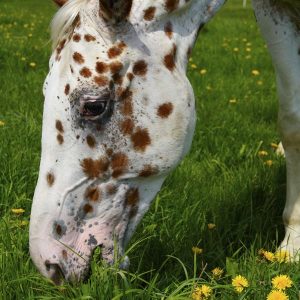
Think “E” for Excellent Nutrition
The far-reaching effects of vitamin E in equine nutrition are well known. Vitamin E plays imperative roles in immune, cardiovascular, circulatory, neuromuscular, and reproductive functions. Horses are unable to synthesize vitamin E, so it is considered an essential nutrient that must be provided in the horse’s diet. Fresh grass is the best source of vitamin E for horses, but they have to graze continuously to consume maintenance amounts. Once grass intake is limited, for any reason, vitamin E availability dwindles.
Horses of all ages can benefit from supplementation, particularly if they do not have regular access to fresh pasture.
Horses at maintenance
Vitamin E supplementation is essential for horses that are not allowed to graze 24/7. The vitamin E content of dried forages such as hay is severely diminished, with forages often losing 75% or more of their vitamin content upon harvesting and storing. Therefore, supplementation with vitamin E is crucial when horses are fed diets almost exclusively composed of preserved forages. Inadequate fortification of textured feeds or the feeding of straight grains (oats, for example) may also contribute to vitamin E deprivation. Supplementation becomes important to horses grazing on winter pasture or those restricted from grazing due to metabolic disease or other illness or injury. Research shows that horses deficient in vitamin E are at a higher risk for developing equine motor neuron disease.
Performance horses
Vitamin E is an essential component to body-wide antioxidant defenses, with one of its most important duties being cell membrane maintenance. Cell membranes are composed largely of unsaturated lipids and are therefore vulnerable to assault by free radicals, compounds that can irreparably damage cell membranes.
As athletic effort increases, free radical production flourishes and natural stores of antioxidants, such as vitamin E, have difficulty providing sufficient protection against the flood of free radicals. Supplementation is therefore necessary to help ward off the ill effects of mass-produced free radicals associated with intense exercise. Horses with an inadequate reserve of vitamin E may experience muscle soreness or stiffness during an exercise bout and prolonged recovery following strenuous work.
Broodmares and foals
Research has lauded the use of vitamin E on breeding farms. Mares supplemented with vitamin E have shown increased passive transfer of antibodies to foals, which ensures the strength of the neonatal immune system. Failure of passive transfer leaves foals susceptible to septicemia and bacterial infections. In a study conducted at the University of Connecticut, researchers found that mares supplemented with vitamin E had higher antibody concentrations in blood and colostrum than the control group of mares. The concentrations of foals reflected those of their dams, with foals from supplemented mares having increased levels of antibodies.
There is also increasing evidence that vitamin E supplementation may increase fertility in mares. Due to modern management practices, including winter breeding dates, mares may not be receiving adequate vitamin E nutrition through rations composed solely of hay and grain. Supplementation will increase circulating levels of vitamin E and may positively affect fertility.
In addition, in some areas of the United States vitamin E is customarily given to all newborn foals to stave off white muscle disease, a serious malady caused by deficiencies of vitamin E and/or selenium.
Horses with neurological and muscular disease
Over the past several years, researchers have been studying the effectiveness of megadoses of vitamin E in the prevention and treatment of neurological diseases such as equine degenerative myeloencephalopathy (EDM), equine motor neuron disease (EMND), and equine protozoal myeloencephalitis (EPM).
EDM affects the brain stem and spinal cord. The disease occurs principally in young horses, and the primary sign is progressive ataxia or incoordination. Researchers have determined that EDM is not a congenital disease, though a horse may have a genetic predisposition to it.
Scientists linked vitamin E deficiency with EDM more than a decade ago. Of particular interest is research conducted at the University of Florida, where scientists worked with EDM-affected offspring of two Standardbred stallions. The mares bred to these stallions and the resulting foals were given 1,500 IU of vitamin E per day. A year after supplementation began, only 10% of the foals were affected. Further offspring of the stallion were not diseased.
Cornell University first identified EMND. Although the cause of the syndrome is unknown, a commonality among horses affected with equine motor neuron disease is reduced exposure to green grass for more than a year and availability of poor-quality hay during that time. Dramatic clinical improvement was documented in horses that were allowed unrestricted access to lush pasture and vitamin E supplementation. Vitamin E is often prescribed for horses with equine protozoal myeloencephalitis (EPM), to be used concomitantly with antiprotozoal medications. It’s not unusual, for instance, for horses to be supplemented with up to 10,000 IU of vitamin E per day during convalescence.
All Sources of Vitamin E Are Not Created Equal
Vitamin E is the most powerful antioxidant in the equine diet. But not all forms of the vitamin are created the same. Synthetic vitamin E (dl-alpha-tocopherol acetate), which is petroleum-based, is not as potent as natural plant-based vitamin E (d-alpha-tocopherol acetate).
Natural forms of alpha-tocopherol have superior bioavailability, being more highly digestible and preferentially metabolized by horses. Moreover, natural alpha-tocopherol is retained in tissues for longer periods of time, creating a reservoir that allows it to be instantly available when horses need it most, namely in times of stress or during periods of confinement. Current research in several species, including horses, shows that natural vitamin E is two to three times more potent than synthetic.
How does a savvy shopper differentiate between natural and synthetic alpha-tocopherol when looking at the labels of nutritional supplements? Natural alpha tocopherol is designated as d-alpha-tocopherol on labels, and synthetic is designated by dl-alpha-tocopherol. In some instances, the ingredient is noted as vitamin E supplement. If this is the case, assume that the alpha-tocopherol is synthetic.



